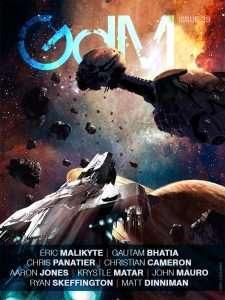Grimdark is a State of Mind
In 1964, when American Supreme Court Justice Potter Stewart was asked to define obscenity so the laws could effectively determine the difference between art and pornography, he said “I know it when I see it.”
 Not exactly a legally binding definition, right? (Relax, I’m not comparing Grimdark to pornography… but more on that later.)
Not exactly a legally binding definition, right? (Relax, I’m not comparing Grimdark to pornography… but more on that later.)
It’s a question I’ve been asking myself ever since I first encountered the term Grimdark, which was around the same time I started making connections in indie SFF publishing. Is it nihilism? Is it bleak? Is it morally grey? Is it borderline splatterpunk? Or is it, as Mark Lawrence (does he need any further introduction in these hollowed pages?) once opined, a genre built on the most tenacious hope there was, a stubbornness determination to try even in the face of certain doom. Whether that doom is from without (the world or other characters in it) or from within (the protagonist’s overwhelming flaws) varies from story to story, but is indeed a familiar archetype within books under the Grimdark spectrum.
Perhaps because of the way authors use the existence of hope in their stories as evidence against their inclusion, Grimdark gathers to itself a reputation of being trauma porn (see, I’m not the one who drew the parallel, someone else drew it for me long before I was a proud member of the community) or the territory of the nihilistic edgelord who shocks for shock’s sake. But I have to admit, I am inclined to agree with Mr. Lawrence. Grimdark can be those things, sure, but so can many genres that dabble in dark. Horror, for example, or true crime, or any genre—fiction or nonfiction—that deals with stories of war, or genres that deal with deep, generational traumas, etc.
To me, the parallels between Grimdark and the attempt to define obscenity/pornography are fascinating. Art that examines (dare I say, celebrates) the extreme edges of the human condition are divisive and hard to define. What does extreme even mean, after all? The definition will be different for every one of us, whether we like it or not. We’ll know it when we see it.
So, if the author doesn’t even know the genre they’re writing, where does Grimdark even come from? And why do the authors of it seem so hesitant to claim the definition for their own bodies of work?
I’ve come to the conclusion that most creative souls have an inclination to create art that grapples with complicated expressions of humanity. That grappling is not exclusive to Grimdark. But once you add to that a certain inclination toward violence described in brutal, uncomfortable detail, a fascination with human flaws and trauma, an existential wondering about what heroism even means, maybe a bit of distrust thrown at The System , and a subversion of comfort, then you begin to build a Grimdark author.
, and a subversion of comfort, then you begin to build a Grimdark author.
Grimdark as a genre holds space for the depths of human depravity, sure, but also for the stubborn assertation that none of us are beyond hope. It gathers to it the traumatized, the broken, desperate, the wretched masses. It is built on big questions, some of them ugly, but all of them important. If heroes can only be unfailingly good, where do we, the tragically imperfect, turn to be seen and understood?
Perhaps the reason we can’t define it and only know it when we see it, is because Grimdark is the genre that sees us and claims us and welcomes us home. Even if—especially if?—we are obscene.
Grimdark is a state of mind. It declares, stubbornly and without surrender, that we all deserve stories. We all deserve art.
This essay was originally published in Grimdark Magazine #39.
The post Grimdark is a State of Mind appeared first on Grimdark Magazine.



